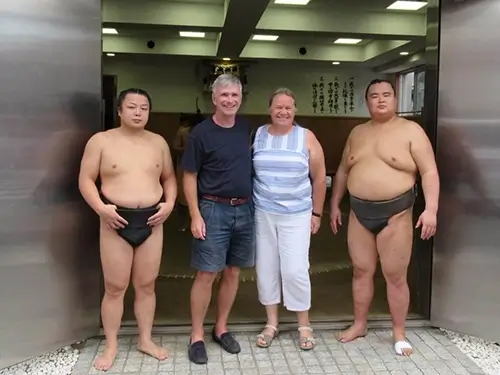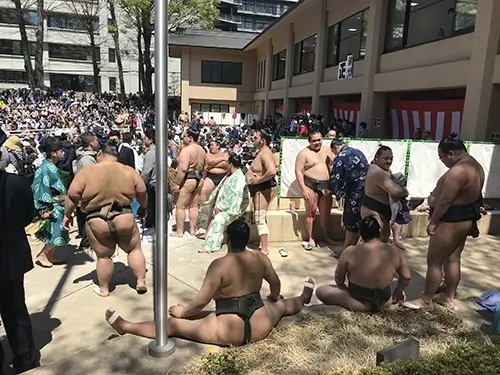While judo and karate are the most popular martial arts to practice outside of Japan, sumo is probably the martial art from Japan that appeals most to the imagination. It is indeed quite the spectacle to watch, and many tourists who come to Japan want to incorporate sumo in their itinerary for exactly this reason. Let’s learn a bit more about the long history of this traditional Japanese martial art and how to see it live!
History of Sumo
Sumo in ancient times was a sacred event to foretell an abundant harvest and to predict the will of the gods. The oldest bout of sumo recorded in history was 642 A.D., and it was adopted as a Shinto ritual in the Court in the 9th century. After the 12th century, when warriors began holding real power in politics, sumo became a practical martial art to be used on the battlefield. In the Edo period (1603-1868) sumo bouts began to be performed as part of shows at festivities at shrines. It was not until the early 20th century when sumo was officially accepted by the government as a martial art with tournaments.


Sumo Nowadays
Today, there are almost 45 sumo stables in Tokyo and sumo wrestlers live there and work out every morning. The total number of sumo wrestlers is around 750 at the moment.
Sumo grand tournaments are held 6 times a year, 3 times in Tokyo. The other 3 tournaments are held in Osaka, Nagoya, and Fukuoka. As sumo has enjoyed a recent uptick in popularity again since there have finally been Japanese wrestlers who attained the highest rank. This happened after years of only foreign wrestlers reaching this rank.
It is not easy to get tickets for tournaments these days. Especially if you want to get good seats and attend matches on one of the final days of the tournament. The last few days tend to be the most exciting to watch. There are two ways to get a ticket. You can buy them in advance (in shops or online). Or you can take a little risk and stand in line the morning you want to get in for the tickets that are sold last-minute. If you want to be sure of being able to attend, we can help you buy your tickets as well.
Morning Practise
Do you want to watch a sumo practice from up close? Attending a morning training session is one of the best ways to do so. It is not possible to just walk in and ask them if you can watch, so you need to be with a guide who reserves your spot for you. There are a few strict rules for visitors which the guide will explain to you before you enter the sumo stable to ensure a smooth experience. We can organize this for you if you are interested. but please note that this tour is subject to availability and only available in Tokyo.
If you are OK with just watching a part of the session from behind a window, there is a stable in Tokyo where you can do this. It is possible to incorporate this in a tour, please mention to us that you are interested in this if you book your tour.
The World of Sumo
The winner of sumo is decided when the opponent is forced out of the ring or when any part of his body touches the ground. In order to become a sumo wrestler, one has to belong to a sumo stable. The stables take care of every aspect of the newcomer’s lives including food, clothing, and housing while training them to become strong wrestlers. It is a man’s world except for the family of the stable master.
Wrestlers are ranked according to their ability. The lowest rank is called Jonokuchi, which is the starting point. There are 9 other ranks, and at the top of the ranks are the Yokozuna or grand champions. Wrestlers above the rank of juryo (the second division) are called sekitori and they receive monthly salaries. What the other wrestlers get is just a small amount of incentive depending on their performance in tournaments.
Sumo Grand Tournaments
As mentioned before, there are 6 official Grand Tournaments per year.
Duration of a Grand Tournament: 15 days:
Months of Grand Tournaments: January, March, May, July, September, and November
Price of a ticket per person: from 3,800 yen ( second floor ) ~
Schedule of a tournament’s day:
- 08:00: Open
- 08:35 ~ tournaments start from lower-ranking sumo wrestlers
- 14:15: Jyuryo dohyoiri and tournaments
- 15:40: Dohyoiri start and tournaments
- 17:30 ~ tournament of Yokozuna and Ozeki
- 18:00 ~ Finish
Your Japan Tour
As seasoned Japan experts, we create perfect Japan package tours including destinations related to sumo wrestling. Check out our group tours and private tours, or contact us to start planning your unforgettable holiday to this fascinating country full of once-in-a-lifetime experiences, culture, history, nature, and delicious food!